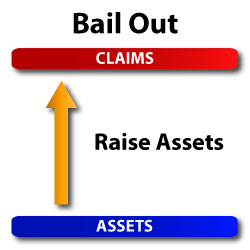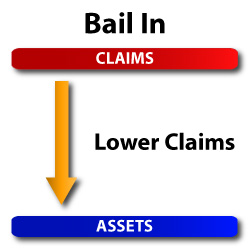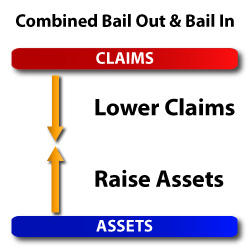Bail In's the New Meachnisms for Stealing Private Wealth
Politics / Banksters Oct 10, 2013 - 04:47 PM GMTBy: Dan_Amerman
 A new method of taking private sector wealth has been spreading around the world this year. This mechanism is called a "bail in", and it is based on the premise that there are certain entities which are too important for the well-being of the general public to allow them to go into bankruptcy or to be liquidated.
A new method of taking private sector wealth has been spreading around the world this year. This mechanism is called a "bail in", and it is based on the premise that there are certain entities which are too important for the well-being of the general public to allow them to go into bankruptcy or to be liquidated.
The new "twist" is that the entity – which could be a major bank, or it could be the public retirement system for an entire country – is not bailed out through using outside funds from the general public, even though the protection of the general public is the reason for the intervention. Instead, funds are taken from the inside, on an involuntary basis, from selected classes of private sector investors who are judged as having the ability to pay, and the costs of maintaining the viability of this entity for the "greater good" are thereby concentrated in a small part of the private sector.
This has been seen in Cyprus with the "rescue" of their banking system. It has also been seen in Poland with the taking of assets from the private retirement system for the benefit of the government and the troubled public retirement system. Bail ins have now also been proposed in Canada when it comes to the preservation of "systemically important" banking institutions.
What it all comes down to is governments and international organizations changing the law, leaving investors without the protections which they thought they had. And this is important not only for banking depositors and investors, but also for anyone who is depending on private sources of wealth for their own retirement or long-term financial security. In this article, we will explore the different ways in which "bail ins" have worked or been proposed in these three real world instances.
What Is A "Bail In"?
The term "bail in" describes a quite different way of preserving troubled entities and keeping them from insolvency or bankruptcy. A bail in is best understood by contrasting it to the more traditional "bail out", and it is important to keep in mind that the two can be used together. That is, the rescue of the Cypriot banking system was a combined bail in of depositors, and a bail out by the European Union and International Monetary Fund.
To begin with, there is an entity – again it could be a major bank or banking system, or a government or government retirement fund – that has more claims against it than it has assets available to pay the claims. This deficiency of assets compared to claims is, of course, the traditional source of bankruptcy or insolvency, whether we're talking about individuals, corporations, or in some cases entire nations.
However, the trend since 2008 has been to not allow bankruptcy when an entity is judged as being too important for the good of the public to let it fail (or at least that is the rationale claimed). And a method has been found to close this gap between claims and assets without going through insolvency or formal bankruptcy proceedings.
A "bail out" rescues an entity by bringing in outside cash and assets, and raising the level of assets until there are enough available to meet the claims and solvency is thereby achieved. The graph below illustrates how this works.

Examples of bail outs occurring on an overt basis include the TARP program in the United States, as well as the government takeovers of AIG, most of the auto industry, and Fannie Mae and Freddie Mac.
A "bail in" approaches this fundamental mismatch between assets and claims from the opposite direction. In a bail in, as illustrated in the graph below, the entity does not go to the outside for new funds. Rather, the gap is closed by reducing the amount of claims outstanding against the entity, until assets match claims and solvency is achieved.

What matters here is that depositors and investors may have legal claims against a bank, for instance, which the bank should not be able to set aside outside of bankruptcy, which itself brings into play its own investor protections. In a "bail in", the government uses its power over the law to take wealth from these investors, set aside their claims, and thereby either avoid the use of public funds for a bail out altogether, or reduce the amount of that bail out.
Cyprus Bail In
The rescue of the major Cypriot banks was a combination of a bail in and a bail out. The bail in component involved depositors with over €100,000 at the major banks being subject to a 60% "haircut".
Of their deposits exceeding 100,000 euros, 37.5% were involuntarily converted into equity shares in an essentially bankrupt banking corporation. Another 22.5% of those deposits over €100,000 were segregated for possible conversion into equity as well, if the deeply troubled bank were to continue to remain troubled and need to further reduce the claims outstanding against it. And by "claims outstanding", this of course comes down to depositors wanting to get their money back.
As illustrated in the graph below, what the bail in served to do was to reduce the size of the bail out by the European Union and International Monetary Fund. Claims were brought down, even as assets were brought in, and (hopeful) solvency was reached somewhere in the middle. So a taking from private investors was combined with a rescue by international organizations.

Now most depositors, including the great majority of Cypriot citizens, got all their deposits back. The way this was accomplished was by targeting only the wealthiest depositors, those with the largest deposits, and taking up to 60% of their money above the minimum amount that was protected.
Now, because Cyprus served as a financial haven for Europe, and most particularly for wealthy Russian investors who were seeking an offshore haven for their cash, what the bail in boiled down to in practice was that most of the domestic population – the voters – didn't take any hit at all, while the wealthy foreigners were stuck with the bill.
Proposed Canadian Bail In Rules
While no Canadian bail ins have yet occurred, the government is proposing implementing new rules, as covered on page 145 of the linked document (the PDF page number is 155), which allow for a "very rapid conversion of certain bank liabilities into regulatory capital" for "systemically important banks".
http://www.budget.gc.ca/2013/doc/plan/budget2013-eng.pdf
Of very significant note is that "certain bank liabilities" is not defined. But the structure is set up in advance, and it allows a Cypriot-type solution in the event of (which the government deems "very unlikely") a situation where the largest banks in Canada need to be rescued. And this would at least partially be accomplished through involuntarily taking claims held (their deposits and investments, in other words) from some parties, but not from others.
And again, while we can't say for sure in advance, the chances are that the money will be taken from the largest depositors, while the average depositor/voter might suffer no losses at all. In other words, there is a redistribution of wealth from "those who can afford it" (or so it will be presented), for the good of all.
The Polish Bail In
The Polish bail in of September 4th, 2013, was quite different from the Cypriot bail in or the new Canadian rules allowing for bail ins. This was not a bail in of a troubled banking system, but rather the entities in trouble were the Polish public retirement system and the Polish government itself.
The second half of the article is linked below.
Daniel R. Amerman, CFA
Website: http://danielamerman.com/
E-mail: mail@the-great-retirement-experiment.com
Daniel R. Amerman, Chartered Financial Analyst with MBA and BSBA degrees in finance, is a former investment banker who developed sophisticated new financial products for institutional investors (in the 1980s), and was the author of McGraw-Hill's lead reference book on mortgage derivatives in the mid-1990s. An outspoken critic of the conventional wisdom about long-term investing and retirement planning, Mr. Amerman has spent more than a decade creating a radically different set of individual investor solutions designed to prosper in an environment of economic turmoil, broken government promises, repressive government taxation and collapsing conventional retirement portfolios
© 2013 Copyright Dan Amerman - All Rights Reserved
Disclaimer: This article contains the ideas and opinions of the author. It is a conceptual exploration of financial and general economic principles. As with any financial discussion of the future, there cannot be any absolute certainty. What this article does not contain is specific investment, legal, tax or any other form of professional advice. If specific advice is needed, it should be sought from an appropriate professional. Any liability, responsibility or warranty for the results of the application of principles contained in the article, website, readings, videos, DVDs, books and related materials, either directly or indirectly, are expressly disclaimed by the author.
© 2005-2022 http://www.MarketOracle.co.uk - The Market Oracle is a FREE Daily Financial Markets Analysis & Forecasting online publication.



